[Editor’s Note: The Mad Scientist Laboratory is pleased to feature today’s post — the winning entry in our Mad Scientist Writing Contest on the 4C’s: Competition, Crisis, Conflict, and Change. CPT Anjanay Kumar‘s winning entry tackles both of our contest’s writing prompts:
-
-
 How will our competitors deny the U.S. Joint Force’s tactical, operational, and strategic advantages to achieve their objectives (i.e., win without fighting) in the Competition and Crisis Phases?
How will our competitors deny the U.S. Joint Force’s tactical, operational, and strategic advantages to achieve their objectives (i.e., win without fighting) in the Competition and Crisis Phases?
-
-
-
- How will our adversaries seek to overmatch or counter U.S. Joint Force strengths in future Large Scale Combat Operations?
-
… plausibly laying out a scenario where China could reunite Taiwan with the mainland under the mantle of the CCP, while operationally and tactically immobilizing the U.S. Joint Force in a lightning fast strike lasting perhaps no longer than a three day weekend — fait accompli — and achieving a stranglehold over the global economy. Read on!]
Purpose
This essay examines how a peer competitor, the People’s Republic of China (PRC), will deny the US Joint Force’s (USJF) tactical, operational, and strategic advantages to achieve their objectives in the Competition and Crisis phases of the Competition Continuum. The PRC’s stated goal of reunification with Taiwan serves as an objective, and the US objective, under the Taiwan Relations Act (TRA), has been to “resist any resort to force or other forms of 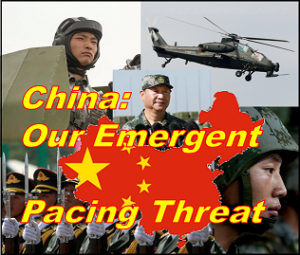 coercion…of the people of Taiwan.”1 After orienting the reader in time and space to our current operational environment, this essay explores the grand strategy through which the PRC will defeat the USJF without fighting and conclude with recommendations to avoid such a defeat.
coercion…of the people of Taiwan.”1 After orienting the reader in time and space to our current operational environment, this essay explores the grand strategy through which the PRC will defeat the USJF without fighting and conclude with recommendations to avoid such a defeat.
Today’s Context: The PRC as a Regional Hegemon
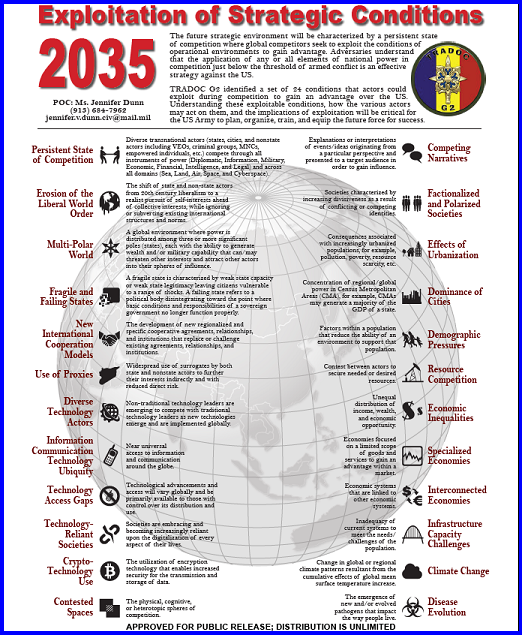
Over the past year, COVID-19’s spread from the PRC has shifted global attention to the PRC’s actions. With the consolidation of rare-earth mines across the world, the creation and militarization of islands throughout the waters of the “nine-dash line” in the South China Sea, and the political costs implicitly associated with the Belt Road Initiative investments, the PRC has spread its economic tendrils across the world.2,3,4 Simultaneously, the PRC has purposefully shaped the overseas perception of the Chinese people and deliberately exported culture: growing PRC influence in Hollywood, shipping of medical supplies to countries in need, and attempts to influence Australian politics are three recent examples.5,6,7 The PRC’s curtailing of rights in Hong Kong serves as an indication that the PRC’s leaders understand the scrutiny their actions across the world are now facing. Perhaps the greatest example of this is the rise of “The Quad”, an ongoing security dialogue between the US, Japan, India, and Australia.8 With the PRC set to become the world’s largest economy by as early as 2028, when the USJF seeks to be Multi-Domain Operation-capable, we must understand that the seeds of their success in extending influence across the world today began decades ago.9
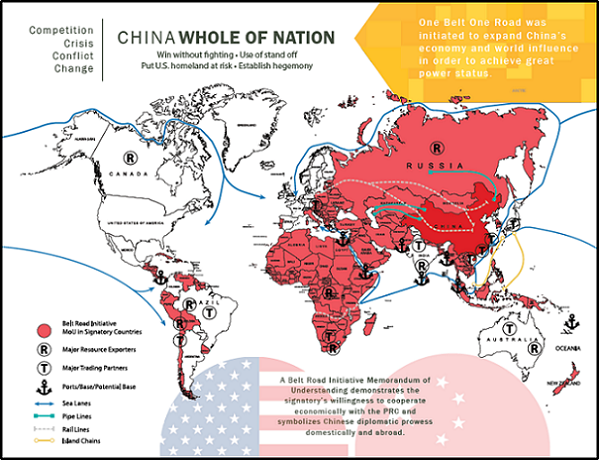
The PRC’s Grand Strategy and Goal
Beginning in 1980, under the “Three Reforms” of Deng Xiaoping, the PRC sought to end the “century of humiliation” and realize the PRC as the “Middle 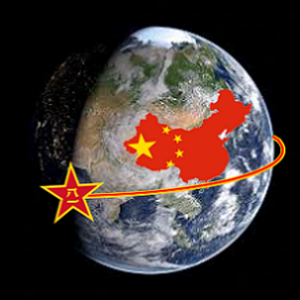 Kingdom.”10,11,12 Published in 1999 by two PRC colonels, Unrestricted Warfare describes in detail how the PRC would execute their vision of a world subservient to the superior Chinese people and culture. Contrary to Western views, the PRC’s approach to war involves all facets of a government, economic system, culture, and people. They correctly identified Western individualism as contradictory to their Confucian, Maoist collectivism and beliefs. Therefore, to achieve the PRC’s grand vision of their culture as the dominant force in the world, the PRC must defeat Western culture and ideology.
Kingdom.”10,11,12 Published in 1999 by two PRC colonels, Unrestricted Warfare describes in detail how the PRC would execute their vision of a world subservient to the superior Chinese people and culture. Contrary to Western views, the PRC’s approach to war involves all facets of a government, economic system, culture, and people. They correctly identified Western individualism as contradictory to their Confucian, Maoist collectivism and beliefs. Therefore, to achieve the PRC’s grand vision of their culture as the dominant force in the world, the PRC must defeat Western culture and ideology.
The radical economic reforms under Deng set the stage for the PRC’s ability to extend influence today. With their rapidly growing prosperity, the PRC realized that they would need to assert economic control on the oil of the future—rare earth metals. The PRC established a near-total monopoly on mines and a massive manufacturing industrial base to refine these metals into usable ![]() products. Not content with dominating the lower tiers of the market, the PRC has also begun creating the higher tier industries that turn refined rare earth metals into semiconductor chips vital to the production of everything from cars to cell phones, to military communications equipment. The situation is in their favor to such a degree that even the US sends rare earth metals to the PRC for refinement, and the US continues to lose ground in the manufacturing arena.13,14 Fundamental to the purpose of this essay and long-term PRC goals, Taiwan is the largest producer of semiconductor chips.15 To achieve the stranglehold they desire, reunification with Taiwan must occur.
products. Not content with dominating the lower tiers of the market, the PRC has also begun creating the higher tier industries that turn refined rare earth metals into semiconductor chips vital to the production of everything from cars to cell phones, to military communications equipment. The situation is in their favor to such a degree that even the US sends rare earth metals to the PRC for refinement, and the US continues to lose ground in the manufacturing arena.13,14 Fundamental to the purpose of this essay and long-term PRC goals, Taiwan is the largest producer of semiconductor chips.15 To achieve the stranglehold they desire, reunification with Taiwan must occur.
The Operational Environment Today
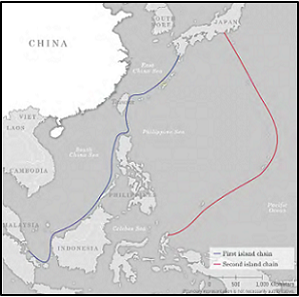
The PRC has been shaping the operational environment since before 2000. As previously described, they have achieved considerable progress in shaping the economic frontline by gaining control of vital economic assets. They have also created significant stand-off with perhaps the most formidable anti-access/area denial (A2AD) bubble anywhere in the world, in the South China Sea. The PRC seeks to use the A2AD bubble to not only deny the USJF freedom of maneuver, but also to control the highly trafficked shipping lanes and rare earth deposits on the sea floor across the region.
In the sociocultural and political domains, the US has practically ceded the fight altogether. Social media has created areas of vulnerability across American society; for example, social media has highlighted racism against Asian people across the US, vilifying the American people.16 Ongoing violence and protests across the country serve the narrative that American democracy is fundamentally racist and hypocritical.17 Americans on social 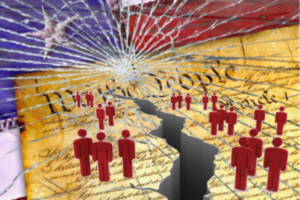 media enter echo chambers that radicalize their beliefs, and the extremes of American society dominate the news cycle. Our adversaries’ ability to manipulate social media using bots and manpower creates a situation in which American is pitted against American, unlike anything the US has seen since the Civil War.18 Additionally, as previously mentioned, the PRC has run a global campaign to improve the perception of the Chinese people, their culture, and their products.19,20
media enter echo chambers that radicalize their beliefs, and the extremes of American society dominate the news cycle. Our adversaries’ ability to manipulate social media using bots and manpower creates a situation in which American is pitted against American, unlike anything the US has seen since the Civil War.18 Additionally, as previously mentioned, the PRC has run a global campaign to improve the perception of the Chinese people, their culture, and their products.19,20
Across Southeast Asia, the PRC’s “Tiger Diplomats” and “Wolf Warriors” have made significant headway, seizing opportunities to increase reliance on the PRC and defeat US interests.21 In the Philippines, for example, with a PRC-bankrolled populist authoritarian in Rodrigo Duterte, the PRC has made 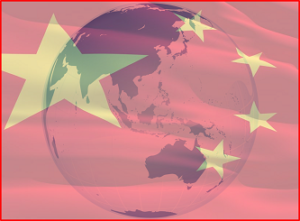 significant strides to subserviate the Philippines.22,23 Thailand, through the Chinese construction of the Kra Canal across the Thai isthmus, stands to benefit greatly from acquiescence to the PRC.24 The Kra Canal would also undermine and economically weaken Singapore, perhaps the staunchest US ally in the region outside of Australia. Vietnam has been consistently bullied by the PRC’s incursions into their exclusive economic zones but has found itself further distanced from the US, like other countries in the region, by harsh language and trade actions under the Trump administration.25 Myanmar’s recent political instability has necessitated a reduction of US military contact, and Cambodia razed and replaced a US-built facility with plans for a new PRC naval base.26 Throughout Southeast Asia, the PRC continues to economically invest in nations.27
significant strides to subserviate the Philippines.22,23 Thailand, through the Chinese construction of the Kra Canal across the Thai isthmus, stands to benefit greatly from acquiescence to the PRC.24 The Kra Canal would also undermine and economically weaken Singapore, perhaps the staunchest US ally in the region outside of Australia. Vietnam has been consistently bullied by the PRC’s incursions into their exclusive economic zones but has found itself further distanced from the US, like other countries in the region, by harsh language and trade actions under the Trump administration.25 Myanmar’s recent political instability has necessitated a reduction of US military contact, and Cambodia razed and replaced a US-built facility with plans for a new PRC naval base.26 Throughout Southeast Asia, the PRC continues to economically invest in nations.27
Japan, South Korea, and Australia hazard antagonizing the PRC and face economic sanctions and cultural backlash when supporting US policies and positions. India, with strong anti-Chinese sentiment over border clashes sensationalized by their populist authoritarian, Narendra Modi, continues to have a complicated relationship with the US due to American support for Pakistan — a necessity for ongoing operations in Afghanistan. [Note: this essay was submitted before the Biden Administration announced its intention to completely withdraw US troops from Afghanistan.] The US finds itself pushed out economically and losing influence daily. Summarily, the USJF will find itself at a severe strategic disadvantage because of decades of shaping operations by the PRC in the political, economic, and sociocultural domains.
Competition to Crisis
With tensions across the region slowly building, Taiwan’s status as a separate state becomes a focal point between the US and the PRC. The TRA compels the US to commit the USJF to support Taiwan against an invasion from the mainland. If Taiwanese politics radicalize against the PRC as political asylum 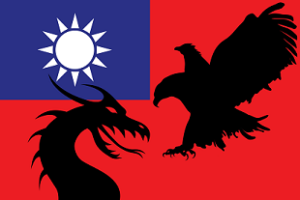 seekers from Hong Kong flood Taiwan, it is feasible that the “red line” of a declaration of Taiwanese independence is crossed and hostilities initiated.28 If the PRC invades Taiwan, they will act against the US and her allies to obfuscate their operational and tactical actions, delay a political reaction, and deny the USJF the chance to engage with PRC forces. The PRC would understand that a victory in Taiwan equates to a failure of American deterrence and would substantially degrade American influence in the region, earning a political victory they desire as much as reintegration. The PRC would also consider the galvanizing effect of US casualties; they will not blunder into Pearl Harbor 2.0.
seekers from Hong Kong flood Taiwan, it is feasible that the “red line” of a declaration of Taiwanese independence is crossed and hostilities initiated.28 If the PRC invades Taiwan, they will act against the US and her allies to obfuscate their operational and tactical actions, delay a political reaction, and deny the USJF the chance to engage with PRC forces. The PRC would understand that a victory in Taiwan equates to a failure of American deterrence and would substantially degrade American influence in the region, earning a political victory they desire as much as reintegration. The PRC would also consider the galvanizing effect of US casualties; they will not blunder into Pearl Harbor 2.0.
US treaties with Japan and South Korea would necessitate non-kinetic operations there as well. With that understanding, the PRC would not substantially target American, Japanese, and South Korean bases and forces with kinetic strikes, instead employing non-kinetic effects to isolate Taiwan. As operations begin against Taiwan, PRC planners will seek to give themselves 72 hours of operations against Taiwan’s military without outside interference. Chinese information operations across social media will overwhelm opposing  messages. Distributed Denial-of-Service attacks will target pro-Taiwanese websites while bots will amplify anti-Taiwanese sentiment by creating social media echo chambers. For 72 hours, the PRC will inundate social media and news agencies with hyperbole and falsities friendly to the PRC’s narrative. Cyber attacks targeting the unprotected physical servers and electrical infrastructure supporting allied intelligence communities will delay the ability to generate a clear picture of the PRC’s actions. As the US Congress convenes in an emergency session to discuss a declaration of war against the PRC, many
messages. Distributed Denial-of-Service attacks will target pro-Taiwanese websites while bots will amplify anti-Taiwanese sentiment by creating social media echo chambers. For 72 hours, the PRC will inundate social media and news agencies with hyperbole and falsities friendly to the PRC’s narrative. Cyber attacks targeting the unprotected physical servers and electrical infrastructure supporting allied intelligence communities will delay the ability to generate a clear picture of the PRC’s actions. As the US Congress convenes in an emergency session to discuss a declaration of war against the PRC, many 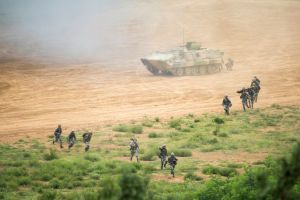 congressmen and women would find their connections to the PRC highlighted across social media and news channels. The PRC would seek to reduce Congress to finger-pointing as they freely invade Taiwan.
congressmen and women would find their connections to the PRC highlighted across social media and news channels. The PRC would seek to reduce Congress to finger-pointing as they freely invade Taiwan.
At an operational level, the PRC will level cyber and electromagnetic warfare capabilities against American carrier strike groups (CSGs). The possible effects CSGs can expect are the hacking of GPS systems causing collisions between vessels, loss of communications, and significant sensor jamming.29
The PRC priority will be to use the defensive capabilities of their A2AD bubbles to create stand-off and threaten the USJF from 4,000 kilometers away.30,31 Furthermore, the extensive use of radars on the “distant water fleet” — civilian ships equipped with military equipment with identical electronic emissions to People’s Liberation Army Navy (PLAN) ships — will add significant breadth and depth to their intelligence gathering apparatus throughout the seas around Taiwan while also disguising the location of PLAN ships.
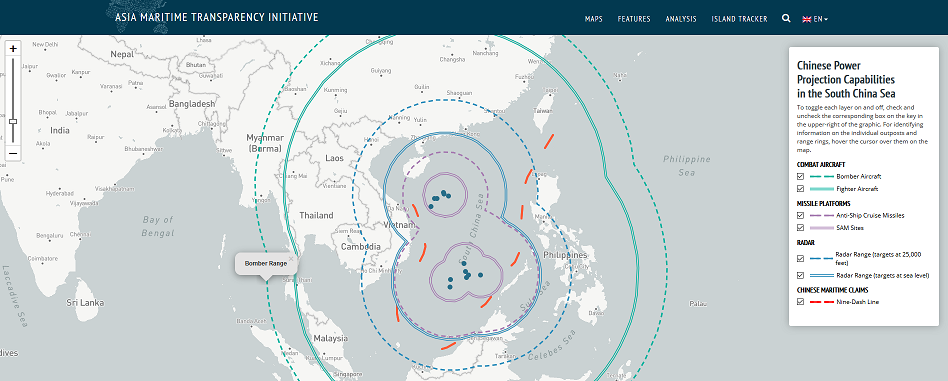
The degradation of systems, the constant threat of ballistic missile attack, blinding across the electromagnetic spectrum, and a lack of unambiguous guidance from higher headquarters would paralyze the USJF on a tactical level. The PRC would further conduct tactical information operations against 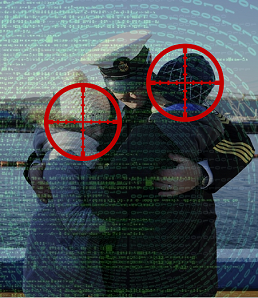 individual USJF service members. Learning from Russian operations against Ukraine, the PRC will target those in leadership positions and those with personal vulnerabilities.32 A ship captain can expect to receive a fake phone call stating his family died in a car crash. A surface warfare officer may receive notification that her house foreclosed, and her family evicted. On the domestic front, families may hear that their loved ones died in accidents.
individual USJF service members. Learning from Russian operations against Ukraine, the PRC will target those in leadership positions and those with personal vulnerabilities.32 A ship captain can expect to receive a fake phone call stating his family died in a car crash. A surface warfare officer may receive notification that her house foreclosed, and her family evicted. On the domestic front, families may hear that their loved ones died in accidents.
The PRC would be prepared to use the “Assassin’s Mace” family of weaponry to defeat the USJF’s tactical advantages.33 These weapons serve as a way to “offset” American technological advantages and supplement stand-off. Currently, there are indications that the PRC has heavily invested in railgun technology, with the precision to target small, quick targets at ranges exceeding 200 km.34 Using real-time intelligence from the Yaogan-31 satellite network over the Pacific, the PRC would add substantial depth to their A2AD bubbles.
 The PRC would also stonewall US attempts at intelligence gathering and analysis. The PRC will target the Sentient program, an AI system capable of digesting vast quantities of data to simplify pattern and trend analysis for human analysts at organizations like the National Geospatial-Intelligence Agency and the National Reconnaissance Office.35 While the Sentient program itself may be secure, the contractors and infrastructure associated with its hardware are not and present a weak point for the PRC to exploit. Before the data moves from the servers, malicious software will attack the servers and causes their physical destruction.
The PRC would also stonewall US attempts at intelligence gathering and analysis. The PRC will target the Sentient program, an AI system capable of digesting vast quantities of data to simplify pattern and trend analysis for human analysts at organizations like the National Geospatial-Intelligence Agency and the National Reconnaissance Office.35 While the Sentient program itself may be secure, the contractors and infrastructure associated with its hardware are not and present a weak point for the PRC to exploit. Before the data moves from the servers, malicious software will attack the servers and causes their physical destruction.
The PRC would achieve a strategic and national advantage over the US and the USJF. They would operationally and tactically immobilize the USJF and maintain sufficient stand-off to win the 72 hours they needed. Taiwan would fall, in this scenario, before Congress declared war on China. From the Chinese perspective, Taiwan’s fall despite American indirect support and a failed attempt at direct support serves as a victory twice over. The US loses total credibility with countries across the western Pacific as a deterrent to the PRC. Worldwide, China’s domination of the semiconductor industry, with control of the next tier of manufacturers in Taiwan, creates a stranglehold over the global economy.
Conclusions
The chief determining factor in the conflict is the PRC’s unity of command—their ability to focus all elements of national power on their objective. Stability in leadership ensured stability in mission and resources, a stark contrast to America’s radical strategic swings from administration to administration. The luxury of having decades to bring a plan to fruition enables greater depth and breadth than largely reactionary US policy can counter.
For the US to prevent the defeat of the USJF before the conflict, the US must go even further than it has in recent years to address Chinese expansion and aggression. First, the US must deepen roots and alliances within the region. “The Quad” presents an opportunity to multilaterally counter the PRC’s moves. India in particular stands to serve as a significant counterbalance, with its 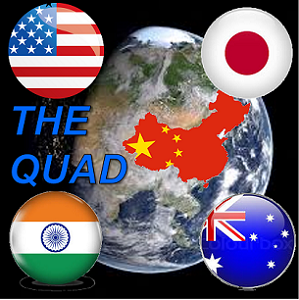 substantial population and strong opposition to the PRC’s territorial claims. The US must continue to deepen defense and economic ties with India through favorable trade terms and inclusion in multilateral military exercises. Luckily, domestic US support for “The Quad” and its implicit objectives of containing and countering China is extremely bipartisan, as are other actions to counter the PRC, such as trade policies under both the Trump and Biden administrations. The next step for the US is to explicitly frame actions against China as the US framed actions against the Soviet Union and Nazi Germany: the PRC’s current regime’s values and beliefs are antithetical to American values and beliefs. This must be an important distinction, as it was when discussing other foes; the enemy is not the people, it is the government.
substantial population and strong opposition to the PRC’s territorial claims. The US must continue to deepen defense and economic ties with India through favorable trade terms and inclusion in multilateral military exercises. Luckily, domestic US support for “The Quad” and its implicit objectives of containing and countering China is extremely bipartisan, as are other actions to counter the PRC, such as trade policies under both the Trump and Biden administrations. The next step for the US is to explicitly frame actions against China as the US framed actions against the Soviet Union and Nazi Germany: the PRC’s current regime’s values and beliefs are antithetical to American values and beliefs. This must be an important distinction, as it was when discussing other foes; the enemy is not the people, it is the government.
The US must also seek to reduce the Chinese monopoly of rare earth metal mining and refinement by creating strong economic and sociocultural incentives to side against the PRC and with the US. The US must vilify Chinese economic imperialism while subsidizing domestic industry and delivering aid and investment to metal-rich nations. Lastly, the PRC’s greatest strength, the mentality under the Middle Kingdom Complex that China is at the center of the world, is also their greatest weakness. Information operations attacking Chinese credibility and legitimacy, such as highlighting the inhumane oppression of the Uighurs, must saturate the information domain. These actions must persist over time, as the US has significant ground to retake. The US must recognize that the PRC has considered itself at war with the US and Western ideology for decades, and it may take a decade or more to realize advances across the economic, sociocultural, and political domains. If hostilities arise, there must be no question that the USJF must deploy expeditiously to give a country such as Taiwan a fighting chance. Without unity of command and belief, the USJF may find itself sidelined altogether, watching helplessly as the PRC realizes its objectives.
If you enjoyed this post, check out the following related ones:
Disrupting the “Chinese Dream” – Eight Insights on how to win the Competition with China and explore all of the additional content on our emergent pacing threat via the embedded links contained therein.
Competition in 2035: Anticipating Chinese Exploitation of Operational Environments
Sub-threshold Maneuver and the Flanking of U.S. National Security, by Dr. Russell Glenn
The Convergence: Hybrid Threats and Liminal Warfare with Dr. David Kilcullen, the associated podcast, and the video [access via a non-DoD network] and notes from Mad Scientist’s Operational Environment and Conflict over the Next Decade webinar on 19 January 2021, featuring Dr. T.X. Hammes. Dr. David Kilcullen, and Dr. Sean McFate
Competition and Conflict in the Next Decade
The Convergence: The Future of Ground Warfare with COL Scott Shaw, and associated podcast
Why the Next “Cuban Missile Crisis” Might Not End Well: Cyberwar and Nuclear Crisis Management, by Dr. Stephen J. Cimbala
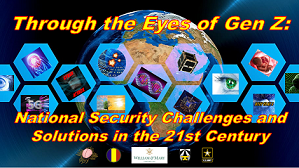 >>>REMINDER 1: Mad Scientist’s next virtual event — Through the Eyes of Gen Z: National Security Challenges and Solutions in the 21st Century — is on Thursday, 29 April 2021 (starting at 1300 EDT). Join us as we collaborate again with The College of William and Mary’s Project on International Peace and Security (PIPS) Program to broaden our aperture on the Operational Environment (OE). We will host two moderated discussion panels where PIPS Research fellows discuss the ramifications of their respective research topics on the OE and the changing character of competition, conflict, and U.S. strategy.
>>>REMINDER 1: Mad Scientist’s next virtual event — Through the Eyes of Gen Z: National Security Challenges and Solutions in the 21st Century — is on Thursday, 29 April 2021 (starting at 1300 EDT). Join us as we collaborate again with The College of William and Mary’s Project on International Peace and Security (PIPS) Program to broaden our aperture on the Operational Environment (OE). We will host two moderated discussion panels where PIPS Research fellows discuss the ramifications of their respective research topics on the OE and the changing character of competition, conflict, and U.S. strategy.
Register here now [via a non-DoD network] to participate in this informative event.
In the meantime, check out what we learned from last year’s event in GEN Z and the OE: 2020 Final Findings to whet your appetite for our upcoming event!
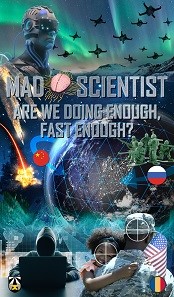 >>>REMINDER 2: Young Minds on Competition and Conflict, the next webinar in our continuing series of Are We Doing Enough, Fast Enough? virtual events – explores our adversaries’ views on Competition, Crisis, Conflict, and Change on Thursday, 6 May 2021 (starting at 1000 EDT). Join our panel of prominent young minds from the national security arena as they share their ideas about the future of competition and conflict for the next decade. Register here now [via a non-DoD network] to participate in this informative event.
>>>REMINDER 2: Young Minds on Competition and Conflict, the next webinar in our continuing series of Are We Doing Enough, Fast Enough? virtual events – explores our adversaries’ views on Competition, Crisis, Conflict, and Change on Thursday, 6 May 2021 (starting at 1000 EDT). Join our panel of prominent young minds from the national security arena as they share their ideas about the future of competition and conflict for the next decade. Register here now [via a non-DoD network] to participate in this informative event.
CPT Anjanay Kumar is currently a member of the Harvard Kennedy School masters of public policy class of 2023. His previous assignments include Deputy Secretary of the General Staff, United States Army Intelligence Center of Excellence and Deputy Intelligence Officer, Joint Task Force Afghanistan. He is a graduate of the Military Intelligence Captain’s Career Course and holds a bachelor of arts in economics from University of California, Berkeley.
Disclaimer: The views expressed in this blog post do not necessarily reflect those of the Department of Defense, Department of the Army, Army Futures Command (AFC), or Training and Doctrine Command (TRADOC).
1 U.S. Congress, House, Taiwan Relations Act, HR 2479, 96th Cong., introduced in House Feb 28, 1979, https://www.congress.gov/bill/96th-congress/house-bill/2479
2 China Power Team. “Does China Pose a Threat to Global Rare Earth Supply Chains?” China Power, July 17, 2020. Updated September 4, 2020. https://chinapower.csis.org/china-rare-earths/
3 Beech, Hannah “Just Where Exactly Did China Get the South China Sea Nine-Dash Line From?” Time Magazine, July 19, 2016. https://time.com/4412191/nine-dash-line-9-south-china-sea/
4 Chatzky, Andrew and James McBride. “China’s Massive Belt and Road Initiative” Council on Foreign Relations, January 28, 2020. https://www.cfr.org/backgrounder/chinas-massive-belt-and-road-initiative
5 Doescher, Tim. “How China is Taking Control of Hollywood” Heritage Explains. December 13, 2018. https://www.heritage.org/asia/heritage-explains/how-china-taking-control-hollywood
6 Australian Associated Press. “China is Seeking to ‘Take Over’ Australia’s Politic System, Former Asio Chief Claims” November 21, 2019. https://www.theguardian.com/australia-news/2019/nov/22/china-is-seeking-to-take-over-australias-political-system-former-asio-chief-claims
7 Searight, Amy. “China Influence Activities with U.S. Allies and Partners in Southeast Asia” Center for Strategic & International Studies, April 8, 2018. https://www.csis.org/analysis/chinese-influence-activities-us-allies-and-partners-southeast-asia
8 Chanlett-Avery, Emma et al. “The ‘Quad’: Security Cooperation Among the United States, Japan, India, and Australia” Congressional Research Service, November 2, 2020. https://crsreports.congress.gov/product/pdf/IF/IF11678
9 Wass de Czege, Huba. “Commentary on ‘The US Army in Mutli-Domain Operations 2028” U.S. Army War College, April 2020. https://publications.armywarcollege.edu/pubs/3726.pdf
10 Kobayashi, Shigeo et al. “The ‘Three Reforms’ in China: Progress and Outlook” Sakura Institute of Research, Inc September 1999. https://www.jri.co.jp/english/periodical/rim/1999/RIMe199904threereforms/
11 Schiavenza, Matt. “How Humiliation Drove Modern Chinese History” The Atlantic, October 25, 2013. https://www.theatlantic.com/china/archive/2013/10/how-humiliation-drove-modern-chinese-history/280878/
12 Ljunggren, Börje. “Under Xi, China Aims to Be the World’s Middle Kingdom.” YaleGlobal Online, October 31, 2017. https://yaleglobal.yale.edu/content/under-xi-china-aims-be-worlds-middle-kingdom
13 Scheyder, Ernest. “China Set to Control Rare Earth Supply for Years due to Processing Dominance” Reuters, May 29, 2019. https://www.reuters.com/article/us-china-usa-rareearth-refining/china-set-to-control-rare-earth-supply-for-years-due-to-processing-dominance-idUSKCN1T004J
14 Reuters Staff. “Chine Explores Rare Earth Export curbs to Target U.S. Defence Industry” Reuters, February 15, 2021. https://www.reuters.com/article/us-usa-china-defence/china-explores-rare-earth-export-curbs-to-target-u-s-defence-industry-ft-idUSKBN2AG0C1
15 Crawford, Alan et al. “The World is Dangerously Dependent on Taiwan for Semiconductors” Bloomberg, January 25, 2021. https://www.bloomberg.com/news/features/2021-01-25/the-world-is-dangerously-dependent-on-taiwan-for-semiconductors
16 Abdollat, Tami and Trevor Hughes. “Hate Crimes Against Asian Americans Are on the Rise” USA Today, February 27, 2021. https://www.usatoday.com/story/news/nation/2021/02/27/asian-hate-crimes-attacks-fueled-covid-19-racism-threaten-asians/4566376001/
17 Blebnikov, Sergei. “China, Russia and Iran Mock U.S. Handling of Protests” Forbes, June 8, 2020. https://www.forbes.com/sites/sergeiklebnikov/2020/06/08/china-russia-and-iran-mock-us-handling-of-protests-i-have-a-dream-but-i-cant-breathe/?sh=7de8e2ba3629
18 Stapleton, Shannon. “FBI Probing if Foreign Governments, Groups Funded Extremists Who Helped Execute Capitol Attack” NBC News, January 16, 2021. https://www.nbcnews.com/politics/national-security/fbi-probing-if-foreign-governments-groups-funded-extremists-who-helped-n1254525
19 Waterson, Jim and Lily Kuo. “China Steps up Western Media Campaign over Coronavirus Crisis” The Guardian, April 3, 2020. https://www.theguardian.com/world/2020/apr/03/china-steps-up-western-media-campaign-over-coronavirus-crisis
20 Zeneli, Valbona and Federia Santoro. “China’s Disinformation Campaign in Italy” The Diplomat, June 9, 2020. https://thediplomat.com/2020/06/chinas-disinformation-campaign-in-italy/
21 Landale, James. “Coronavirus: China’s New Army of Tough-Talking Diplomats” BBC News, May 13, 2020. https://www.bbc.com/news/world-asia-china-52562549
22 Rowand, Michael. “Duterte Will Fight Anyone but Beijing” Foreign Policy, October 19, 2020. https://foreignpolicy.com/2020/10/19/duterte-philippines-china-interests/
23 Westcott, Ben and Steven Jiang. “China is Embracing a New Brand of Foreign Policy” CNN World, May 29, 2020. https://www.cnn.com/2020/05/28/asia/china-wolf-warrior-diplomacy-intl-hnk/index.html
24 Menon, Rhea. “Thailand’s Kra Canal: China’s Way Around the Malacca Strait” The Diplomat, April 6, 2018. https://thediplomat.com/2018/04/thailands-kra-canal-chinas-way-around-the-malacca-strait/
25 Thu, Houng Le. “Rough Waters Ahead for Vietnam-China Relations” Carnegie Endowment for International Peace, September 30, 2020. https://carnegieendowment.org/2020/09/30/rough-waters-ahead-for-vietnam-china-relations-pub-82826
26 Davidson, Philip. “Statement Before the Senate Armed Services Committee on U.S. Indo-Pacific Command Posture” March 9, 2021. https://www.armed-services.senate.gov/imo/media/doc/Davidson_03-09-21.pdf
27 Lima, Guanie and Alvin Camba. “China Investment in Southeast Asia is Nothing to Fear” Nikkei Asia, August 4, 2020. https://asia.nikkei.com/Opinion/Chinese-investment-in-Southeast-Asia-is-nothing-to-fear
28 Murphy, Colum. “China Diplomat’s ‘Red Line’ Warning Points to U.S. Tensions.” Bloomberg, February 3, 2021. https://www.bloomberg.com/news/articles/2021-02-02/china-s-top-diplomat-warns-biden-not-to-touch-internal-affairs
29 Pomerleau, Mark. “Breaking Down China’s Electronic Warfare Tactics” C4ISR Net, March 22, 2017. https://www.c4isrnet.com/c2-comms/2017/03/22/breaking-down-chinas-electronic-warfare-tactics/
30 Asia Maritime Transparency Initiative. Chinese Power Projection Capabilities in the South China Sea. Last modified February 28, 2021. https://amti.csis.org/chinese-power-projection/
31 Kristensen, Hans. “China’s New DF-26 Missile Shows Up At Base In Eastern China.” Federation of American Scientists, January 21, 2020.
32 Scarasso, Lucas. “Text Messages from Hell: Restraint and Information Warfare” Modern War Institute, April 21, 2020. https://mwi.usma.edu/text-messages-hell-restraint-information-warfare/
33 Work, Robert O., and Greg Grant. “Beating the Americans at their Own Game.” Center for a New American Security: 4-10.
34 Macias, Amanda. “China Just Tested the World’s Most Powerful naval Gun and U.S. Intelligence Says it will be ready for Warfare by 2025” CNBC, January 30, 2019. https://www.cnbc.com/2019/01/30/cnbcs-amanda-macias-china-just-tested-the-worlds-most-powerful-naval-gun-and-us-intelligence-says-it-will-be-ready-for-warfare-by-2025.html
35 Scoles, Sarah. “Meet the US’s spy system of the future – It’s Sentient.” The Verge, July 31, 2019. https://www.theverge.com/2019/7/31/20746926/sentient-national-reconnaissance-office-spy-satellites-artificial-intelligence-ai



